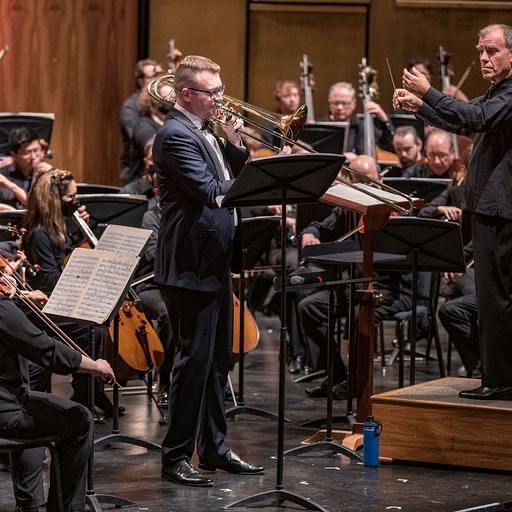by Stephanie Manning

The piece, along with that reading, is just one example of the Symphony’s aim this season to elevate the music of underrepresented composers. On September 24 in E.J. Thomas Hall, the ASO’s 2022-23 season began with “American Fanfare,” which explored the complexities of American identity and culture.
That’s not to say that the concert avoided any patriotic pomp. After musicians and audience stood for a stately rendition of the national anthem, the brass section made a big statement during Aaron Copland’s Fanfare for the Common Man, locking their sound into a beautiful blend.
After the barrage of brass and percussion, the strings got two short pieces of their own. Florence Price’s lush “Andante moderato,” arranged from the second movement of her String Quartet in G, highlighted the ensemble’s lyrical abilities. Though the musicians tended to sit behind the beat, Wilkins tightened up his beat pattern for Tate’s “Moccasin Game.”
The piece — the second movement of his Shakamaxon —depicts a type of game that requires intense focus. This was embodied in the demands on the musicians: quick pizzicato, ever-changing rhythms, and the hitting of strings with small sticks. Though there were a few moments when the rhythmical locking began to fray, the effect of the piece was mostly maintained.
The full orchestra returned to the stage for William Grant Still’s Symphony No. 2, “Song of a New Race,” which closed out the first half. Still knows how to write a great melody, and this work’s catchy themes evolve like a movie score — particularly during the cinematic brass fanfare in the fourth movement. The tempos dragged at times during the pastoral second movement, but the jazzy third movement kept things interesting. Still’s rich wind writing allowed for a number of tasteful solos from the principal players, particularly Cynthia Warren on English horn.
Like Still, George Gershwin had his feet in two worlds when it came to orchestral composition, blending Broadway and jazz idioms with a contemporary classical flair. The musicians approached An American in Paris with relish, giving the repertoire staple an impressively spirited opening. Some of the tempo choices were a bit overeager, but it was a great fit as the concert’s finale.
Topping off the big evening for the brass section was George Walker’s Trombone Concerto, performed by ASO principal John Gruber. His assertive playing and wonderfully mellow tone cut through the work’s undulating, uneven rhythms in the orchestra. The second movement was a highlight, creating a mysterious fog that was only dispelled too soon due to the movement’s short length.
Although the audience’s reaction to earlier pieces was somewhat tepid, that pattern was broken after Gruber’s triumphant finish. Many — including Gruber’s students from Oberlin Conservatory — quickly got to their feet to contribute loud cheers.
Published on ClevelandClassical.com September 29, 2022.
Click here for a printable copy of this article



